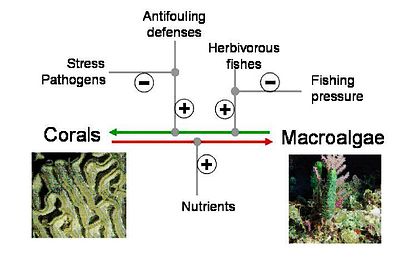|
|

|
|
Putative direct and indirect drivers of a regime shift between coral-dominated and macroalgae-dominated reef communities
|
Nutrient gradients in the Red Sea: How do they correlate with plankton abundance and diversity, and with macroalgal-coral interactions?
German coordinators: Prof. Dr. Martin Wahl
Saudi coordinator: Dr. Abdulmohsin A. Al-Sofyani
German scientists: Dr. Benjamin Kuerten, Dr. Monika Winder
Saudi scienitists: Dr. Ali M. Aidaross, Dr. Hisham Khomais, Dr. Waleed Y Gharbawi
Anthropogenic ocean eutrophication executes an increasingly severe environmental pressure especially on coastal marine habitats and enclosed seas - particularly so when interacting with other stressors such as overfishing. The Red Sea ecosystem features nutrient gradients at several scales – none of them well explored and some rather expected than proven.
We are going to explore the effects of eutrophication at several spatial scales on the trophic web structure in the plankton and on the competitive interaction between corals and macroalgae. The findings will provide tools to evaluate and hopefully avoid man-made regime shifts in the Red Sea.
Scientific goals
Subproject 1: Food web structure
-
because of its longitudinal eutrophic-oligotrophic gradient and local nutrient gradients starting from coastal point sources of eutrophication.
-
because of its high functional diversity of zooplankton, from small particle-feeding (“microphageous”, particles <5 µm) tunicates and ostracods to macrophageous copepods and predatory amphipods.
Our research questions are based on the hypothesis that the length of the food chain from primary producers to mesozooplankton and planktivorous fish should depend on nutrient richness and Si:N ratios. Nutrient-rich conditions with high Si:N ratios (as prevailing on the southern end of the longitudinal gradient) should lead to a high share of diatoms, which are directly fed upon by copepods. Thus, they would occupy trophic level 2 and planktivorous fish trophic level 3. Low nutrient conditions lead to a dominance of phytoplankton too small for copepods. Therefore, protozoa act as intermediate trophic level, putting copepods to trophic level 3 and planktivorous fish to TL 4. Under nutrient-rich, low-Si conditions (coastal eutrophication), armored or toxic dinoflagellates and other harmful algal blooms resist copepod grazing and channel carbon through decomposition and bacteria into the food web, thus also making food chains longer. However, it is unclear to which extent microphageous mesozooplankton can short-cut this elongation of food chains.
To reconstruct the structure of the lower pelagic food web, a complementary approach will be adopted to study the composition of primary producers available as food sources to higher trophic levels of the pelagic food web and to determine macronutrient fluxes that are susceptible to change, due to changes in environmental conditions, or human impacts.
Food sources for higher trophic levels and zooplankton trophodynamics will be characterised by combinations of chemical- and biological-oceanographic information including seawater chemistry, microscopic analysis and phytoplankton pigment fingerprinting with bulk stable isotope analysis of carbon and nitrogen and flow cytometry.
Subproject 2: Coral-macroalgae competition
When macroalgae overgrow stony corals, reefs may be seriously endangered. This may happen when herbivorous fishes are overexploited, when the growth of macroalgae is enhanced as an effect of eutrophication and/ or when the antifouling mechanisms of the corals are weakened. Thus, environmental stress may be mediated and amplified by biotic interactions. The Red Sea is well suited to investigate the large potential of such indirect effects because it features one of the richest reef systems, but also large-scale and small-scale nutrient gradients and a heterogeneous fishing pressure.
We expect to find healthy and diverse reef communities where nutrients are moderate to low, where fishing pressure is low and where the stony corals are not directly stressed by extreme temperatures, pollutants, pathogens, divers or other damaging factors. On the other hand, we expect an encroachment by macroalgae in areas of intense fishing, of high nutrient levels and when coral defenses are weakened.
In this project we are going to evaluate the health of shallow (< 50m depth) reefs in selected regions which differ in the principal putatively stressful factors (fishing pressure, eutrophication), but are similar otherwise. These areas should represent the large-scale S-N nutrient gradient, as well as more localized anthropogenic stress gradients near centres of human activity (e.g. Jeddah). "Health" will be assessed using proxies such as the percentage of live corals, species richness and prevalence of macroalgae on stony corals. Data on the intensity and variability of the two stressors will be obtained by literature search, interviews of local scientists and on-site observation. In cooperation with local students/scientists, caging-fertilization experiments may be considered.
|